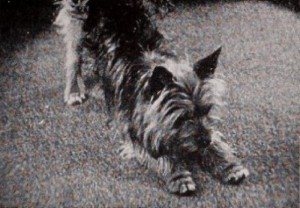"considering the obvious difficulty of getting anywhere near the subject to be photographed, is an amazing piece of work, as regards photography, choice of shots, continuity, cutting, and editing. It is no exaggeration to say that a professional could have done no better. The whole grim business of the fight is depicted in a vivid and realistic manner, and but for the fact that the Censor and general public are averse to witnessing spectacles of this type of picture, if enlarged to standard size, could be shown in the cinemas" (Hill 1931: 7).

"A young girl and an Australian terrier named Frisco are the ingredients of Calling Frisco, a sound on film story in which the speech is mostly from the dog's point of view. The film flows smoothly through typical scenes of a day's activities of eating and going to market and playing, ending in a dramatic climax in which Frisco protects his young mistress by warning off an intruder. Imaginative viewpoints and pleasant interior lighting are employed throughout. The dog's simple tricks are well pictured without being obtrusive, while the scene in which a bouncing ball lands in a goldfish tank, with its accompanying sound track, has the creative fantasy of Disney. Cyril Stevens has made a jolly film. " Movie Makers, Dec. 1948, 493.
"Charles and Robert Coles showed a fine knowledge of the use of filters in their twin subject, 'Cascade and World's Fair.' Also they showed a grasp of composition and camera angles that was refreshing." American Cinematographer, Dec. 1933, 342.
"Film opens with a shot of a camera and projector. Following scenes include family footage of two girls dancing in a garden; shots of a birdbox, beehive and female beekeeper; snowy street scenes; a child playing with a lamb; women participating in an outdoor gymnastic display and brief footage of a cricket match at Ashley." (NWFA Online Database)
"Among the ten best, Century of Progress, in Kodacolor, by Herbert H. Johnson, ACL, is a striking illustration of the degree of perfection that color motion picture photography has attained. Its studied angles and dignified composition are augmented by excellent photography. Mr. Johnson paid careful attention to the very important point of exact exposure in relation to color value and, as a result, brought a new version of the Fair to the one who had never seen it in color before. By taking plenty of time he was able to single out the best camera positions and wait for the lighting that was most favorable. The excellent handling of the camera brought a sense of intimacy to each scene. The film's only fault is an excessive use of lap dissolves which detracted somewhat from the smoothness of the continuity." Movie Makers, Dec. 1933, 499.
"A Century of Progress, the one reel record of the Fair in Kodacolor, by Edmund Zacher, II, ACL, is distinguished by the freshness of its dramatic treatment rather than by the faultless excellence of technique. In this latter field, Mr. Zacher, choosing to experiment along relatively unblazed color trails (slow motion, night photography, dissolves, etc.) has on occasion made slight errors, a fact which he himself is the first to admit. Dramatically, however, his film is a joy and a delight, replete with human interest, unhurried but unflagging in its presentation of the Fair from ever fresh viewpoints." Movie Makers, Dec. 1933, 523.
"Interior shots of a woman with a young child sat on her knee. Cuts to a shot of a woman and child playing in a field. The child sits on an adult's bicycle and the woman pushes it across the field towards the camera. A dog follows on behind" (NWFA Online Database).
"Family footage shot in the garden of a house situated on The Beeches in West Didsbury; April 1925. Includes various scenes of a baby and child, sitting in a pram and playing with their nanny" (NWFA Online Database).
"Children playing in the Behrens family garden. Includes shots of two little girls sitting on a small wooden horse and a toddler wearing a knotted handkerchief on its head" (NWFA Online Database).
"Children Grow Up, photographed by Charles J. Carbonaro, ACL, and produced by The Religious Motion Picture Foundation, is one of the best examples of effectively handling amateur actors in a story telling film yet made. This three reel film was avowedly produced to point a moral in parent and child relationships and, as such, may be classed as social propaganda, a function in which it succeeds admirably. Yet the story it tells seems genuine and is of general audience interest. The film is carefully cut so that the action is logical and smoothly paced. Mr. Carbonaro is particularly to be congratulated for his handling of the difficult technique of parallel action, which occurs as the development of the children of two separate families takes place. Both streams of interest merge into one in a well planned, dramatic climax. The story is told entirely with the aid of amateur actors. Interior shots are in the majority and, for these, no special sets were built, the furnishings of the ordinary home being used. The lighting and exposure under these conditions are excellent throughout." Movie Makers, Dec. 1935, 534.
Total Pages: 29